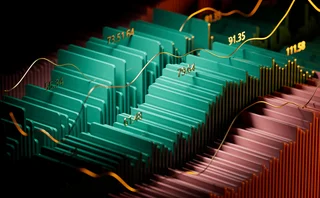Dark horse: Deutsche Börse building dark pool
New functionality allowing exchange members to execute sweep trades comes hot on the heels of European rival Euronext launching its own dark pool.

Deutsche Börse is developing a central midpoint dark pool, which is due to launch in November 2024, WatersTechnology has learned. The move mirrors Euronext, Europe’s largest exchange, which will unveil its own dark pool next week.
A source familiar with the project says Deutsche Börse is in the process of building its dark venue, with prototypes made and some testing already completed. “They think there’s good reason why their midpoint book can become attractive and why it could be established next to the existing ones,” says the source. “Of course, they are a late mover now. And the same is true for Euronext,” they add.
A second source familiar with the matter says: “Deutsche Börse plans to follow [Euronext] with its own dark pool in Q4 this year.”
Dark pools, where financial institutions can trade against counterparties without first displaying their order, have played a growing role in European markets for the last 15 years. But in 2018, after the proportion of shares traded on unlit venues had surged from 1% to 8% in just seven years, the European Union imposed limits on the proportion of trading that could take place in the dark for individual stocks.
Deutsche Börse Cash Market is developing a midpoint trading functionality that will be integrated into the Xetra market. The envisaged launch is in November 2024
Spokesperson for Deutsche Börse Group
That ‘double volume cap’—which has until now limited the proportion of trading that takes place in the dark both for specific venues and for the entire market on aggregate—is about to be liberalized under the EU’s revised Markets in Financial Instruments Regulation (Mifir), eventually removing the limitation for each venue.
A spokesperson for Deutsche Börse Group says: “We confirm that Deutsche Börse Cash Market is developing a midpoint trading functionality that will be integrated into the Xetra market. The envisaged launch is in November 2024."
The first source familiar with Deutsche Börse’s project says the drivers behind it are not just regulatory. The success of other dark pools in Europe—such as Cboe, Turquoise, and Aquis—have demonstrated the demand for dark trading, and Europe’s lit markets must offer clients an alternative. If not, the source says, “it’s clear that they [would] leave.”
“‘Xetra Midpoint’ is a customer-driven project; large member firms asked us to deliver a midpoint service as an integrated solution in the heart of price discovery for German instruments. We can offer full synchronicity of midpoint prices for these instruments, as the midpoint order book and the Xetra central limit order book (Clob) will be hosted in the same location... Sweep orders offer a chance for a price improvement against the best bid and offer in the clob, and will have no latency disadvantage compared to orders that go directly into the Clob. More details will be disclosed in due time prior to launch,” says the spokesperson for Deutsche Börse Group.
Double trouble
Building a dark pool is a particularly complex undertaking for exchange operators, who need to account for the impact that it could have on their lit venue—both in terms of liquidity and latency. By running a second order book in tandem, they are introducing an extra layer of technical complexity.
As the price of a share on a dark pool is derived from the midpoint of its price on the lit venue, the two books are fundamentally integrated, but it is also crucial that sweep orders—where firms send the order to the dark book first, and any unfilled volume is sent onward to the lit book—do not put participants of the dark pool at a time disadvantage once their order arrives on the lit venue.
“How is the interaction of those two order books within your own machines basically organized? And how quick are you in processing those sweep orders?” asks the first source familiar with the project, adding that Deutsche Börse is “currently putting quite a lot of effort into a technical implementation that synchronizes those two books so that there’s a strict sequencing between orders that go directly to the lit book, and those that take those sweep orders on a detour to the midpoint book.”
There is also an optimization problem that the exchange operators need to negotiate when designing a dark pool. Whereas a lit venue simply matches an incoming order against any available liquidity on the other side of the trade, a midpoint book needs to be more responsive to the nature of the order and to changes in the reference price. It is possible to have a limit order on both sides of the trade, but the reference price does not allow them to be executed against each other. But if the best bid and offer for that share on the lit venue changes, the new reference price will allow the two orders—and even multiple other resting orders—to be matched against each other.
Another complicating factor is the need to introduce a minimum acceptable quantity (MAQ) function. Firms trading in dark pools often do so to limit the impact of large orders on the market. To prevent high-frequency traders from pinging the dark pool with small resting orders that could reveal a firm’s intention to buy or sell a share in larger quantities, members often request that their trades are only executed against a counterparty offering a minimum acceptable quantity, adding more elements to the matching algorithm. Going iteratively through the book to aggregate trades in order to meet a larger MAQ order can also be very time-intensive.
This will not be Deutsche Börse’s first foray into dark trading. The exchange first launched its Xetra MidPoint dark pool in 2008, but closed it in 2017. Deutsche Börse attributed the closure to an incoming law exempting large orders on lit venues from pre-trade transparency requirements, which it said reduced the need for small-sized transactions in dark pools.
In 2013, Credit Suisse and Morgan Stanley stopped participating in Xetra MidPoint after Deutsche Börse partnered with agency execution specialist Liquidnet, allowing large orders on its dark venue to be matched against liquidity on Liquidnet’s books. This led brokers to express concern about the possibility of information leakage, The Trade reported at the time of the closure.
Duels in the dark
Deutsche Börse is not the only European exchange planning a move into the dark pool space. Euronext is opening a dark pool next week. The first stage will see Euronext Belgium’s listed stocks made available for dark trading, followed by the rest of Euronext’s markets in April.
Vincent Boquillon, head of cash equities at Euronext, tells WatersTechnology that the process of designing and launching a dark pool—in consultation with seven different national regulators—has taken a lot of consideration. Even with experience operating Goldman Sachs’ dark pool, Sigma X, it took Euronext around six months to build its new offering. Rather than starting with an array of different parameters, Euronext will initially offer a handful of order types, including sweep trades, MAQ, and immediate-or-cancel orders (where any portion of the trade left unfilled is canceled).
“We don’t have the pretension or ambition of reinventing the wheel. What we decided is to come up with a very industry-standard set of services. Dark and the services around dark are already very well embedded within the brokers, smart order routers, etcetera,” Boquillon says. “So, for us to basically align with what the industry has as a standard offering makes it very plug-and-play for the participants.”
While he recognizes the difficulties of launching a dark book and winning market share from existing dark pools, Boquillon says that a peculiarity of European market structure will play to Euronext’s advantage.
London-based multilateral trading facilities (MTFs) offering European shares in the dark derive their reference prices from the bid-offer spreads on the lit venue where the security was listed. In the case of Euronext, which migrated its datacenter from the UK to Italy in June 2022 following its acquisition of Borsa Italiana, updated prices take around eight milliseconds to reach London. Research by Euronext states that almost a third of dark trade prices on MTFs are stale, giving market participants with faster datafeeds the opportunity to see and benefit from the favorable prices. In practice, the majority of large sell-side institutions use slower, fiber-optic connections. High-frequency trading firms, on the other hand, are more likely to employ a microwave infrastructure, allowing them to communicate with markets in half the time.
For this reason, as well as Euronext’s existing relationships with brokers across Europe who might not currently participate in dark markets, Boquillon contends that the exchange’s dark pool could attract order flow from competitors rather than simply diverting flow away from its lit venue.
“It might be a bit contradictory for a lit exchange to say, ‘I’m going to launch in the dark, and it’s not going to affect the lit book’—actually, this is what we think. Today, when you do a dark-to-lit sweep, because of that latency consideration, you’re more likely to do the lit leg on the venue where you’ve done the dark print than you are to do it on the venue that is eight milliseconds away. So there is a level of stickiness when you do a sweep,” Boquillon says.
The first source familiar with Deutsche Börse’s plans says the German exchange, with a datacenter in Frankfurt, is in a similar situation to Euronext. They add that Deutsche Börse will be watching the launch next week carefully to see whether they can learn anything from it, “and, ideally, even ride the wave of any momentum that [Euronext] might create.”
Further reading
Only users who have a paid subscription or are part of a corporate subscription are able to print or copy content.
To access these options, along with all other subscription benefits, please contact info@waterstechnology.com or view our subscription options here: http://subscriptions.waterstechnology.com/subscribe
You are currently unable to print this content. Please contact info@waterstechnology.com to find out more.
You are currently unable to copy this content. Please contact info@waterstechnology.com to find out more.
Copyright Infopro Digital Limited. All rights reserved.
As outlined in our terms and conditions, https://www.infopro-digital.com/terms-and-conditions/subscriptions/ (point 2.4), printing is limited to a single copy.
If you would like to purchase additional rights please email info@waterstechnology.com
Copyright Infopro Digital Limited. All rights reserved.
You may share this content using our article tools. As outlined in our terms and conditions, https://www.infopro-digital.com/terms-and-conditions/subscriptions/ (clause 2.4), an Authorised User may only make one copy of the materials for their own personal use. You must also comply with the restrictions in clause 2.5.
If you would like to purchase additional rights please email info@waterstechnology.com
More on Trading Tech
Recent volatility highlights tech’s vital role in fixed income pricing
MarketAxess’ Julien Alexandre discusses how cutting-edge technology is transforming pricing and execution in the fixed income market amid periodic bouts of volatility
Banks fret over vendor contracts as Dora deadline looms
Thousands of vendor contracts will need repapering to comply with EU’s new digital resilience rules
Where have all the exchange platform providers gone?
The IMD Wrap: Running an exchange is a profitable business. The margins on market data sales alone can be staggering. And since every exchange needs a reliable and efficient exchange technology stack, Max asks why more vendors aren’t diving into this space.
This Week: Trading Technologies completes ANS deal; State Street; Equinix; and more
A summary of the latest financial technology news.
Interactive Brokers looks beyond US borders for growth opportunities
As retail trading has grown in volume and importance, Interactive Brokers and others are expanding international offerings and marketing abroad.
JP Morgan’s goal of STP in loans materializes on Versana’s platform
The accomplishment highlights the budding digitization of private credit, though it’s still a long road ahead.
As data volumes explode, expect more outages
Waters Wrap: At least for those unprepared—though preparation is no easy task—says Anthony.
This Week: ICE Bonds and MarketAxess plan to connect liquidity networks, TS Imagine, Bloomberg, and more
A summary of the latest financial technology news.








